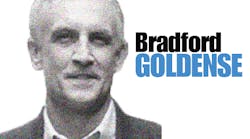The question posed in the headline has been debated by many over the years. Few have dared to commit their conversations on the topic to writing. That’s likely because folks who write up early findings on a new area or approach to a scientific study, and are later proven incorrect, often have difficulty regaining their prior ground. However, they do push the state of thinking ahead, albeit without reward.
Almost without exception, discussions about invention and innovation that have taken place in my circles over a long period of time have clearly concluded that innovation comes first: Invention follows innovation. Don’t you agree? (Machine Design’s readership is quite sophisticated and is involved with both subjects. Should you be so inclined, the editorial staff would welcome your thoughts.)
The Merriam-Webster dictionary defines invention as “a product of the imagination; device/contrivance/process originated after study and experiment.” Innovation is defined as “the introduction of something new; a new idea/method/device.”
What both concepts have in common is “new.” Interestingly, the word “new” is not part of both definitions. But, everything about the definitions imply something new. Can we agree that there are no “old innovations” or “old inventions?” If so, that bounds the discussion to the number of ways the word “new” be sliced. Let’s investigate three cases of “new.” The three cases are: New-To-The-Company, New-To-The-Industry or a Market, and New-To-The-World.
New-To-The-Company: Many engineers and scientists necessarily get excited about working on something that is new to their company. In the big picture, however, that means others have done it before. While the efforts of company employees may result in an invention for the company, it is an innovation on work that originated elsewhere. Therefore, innovation precedes invention in this case.
New-To-The-Industry or New-To-The-Market: (It is important to clarify that this term excludes items that are New-To-The-World, described below.) There are many examples where, in the daily vernacular of the workplace, all these terms are coincident. Regular culprits are analytical and diagnostic instruments; there are also many in the computer industries. A base technology or capability packaged for one industry is often adapted to entirely new purposes or applications in other industries. But in those other industries it was not New-To-The-World. It was not a first-in-the-world discovery of an enabling capability or technology. Hence, innovation precedes invention in this case, as well.
New-To-The-World: This type of “new” is clearly a discovery. It is, to borrow a phrase from Star Trek, "to boldly go where no man has gone before.” Merriam-Webster’s definition of invention includes the words “a product of the imagination,” and “originated after study and experimentation,” and it aligns with Star Trek’s wonderful phrase. Without arguing whether Mr. Edison actually invented the light bulb, it would be difficult to say he “innovated on a candle” or “innovated on a gas lamp.” Without arguing whether Mr. Ford actually invented the car, it would also be difficult to say he “innovated on a horse and buggy, or a sleigh.” Or, that Mr. Ford simply assembled various components of the emerging machine tool industry during the 40 years that preceded the Model T. How about, "the Wright Brothers innovated on a bird," or "Alexander Fleming innovated on mold?" These statements just don't seem right. That’s because, in these cases, invention preceded innovation.
In most new-to-the-world scenarios, invention precedes innovation. W. Chan Kim, in his book Blue Ocean Strategy, says only 14% of new products are New-To-The-World. For most of those new products, it can be argued that invention preceded innovation. Perhaps that is why those 14% of products generate 38% of global revenues and 68% of global profits.

